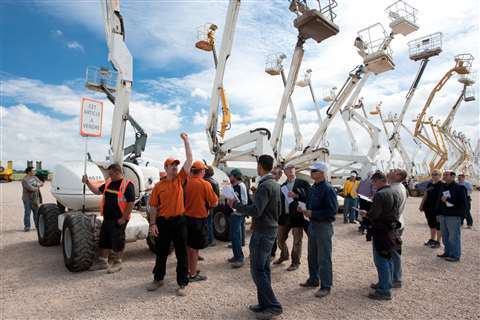Lindsey Anderson reports on the used access equipment market
30 January 2012

The aerial industry is finally moving forward with demand for new equipment after years of being stagnant due to the economic downturn and recession. When the rental industry suddenly defleeted both old and new models a few years ago, the market became flooded with excess equipment. However, according to some in the industry, a vast decrease in the availability of used equipment has suddenly taken form.
"Not only is there less used equipment available, but as shortages grow, prices are on the rise," says Steve Watts, Snorkel's vice president of sales and marketing for the Americas. "Between 2009 and 2011, the pricing of used aerial equipment has shot up by as much as 20 percent."
This increase in price is a result of the lack of purchasing from major rental and other accounts from 2008 to 2010, which has created a shortage of used equipment today, as has the increased demand for aerial equipment in the growing South American market.
Today, however, rental companies continue to sell off used access equipment, but do so strategically to maximize their physical utilization requirements. As new equipment arrives from manufacturers, rental companies sell off the older assets when they come off rent.
Many under-utilized machines, however, have already been sold and demand continues to grow for models from 2007 and beyond - which can make access equipment very desirable at auctions.
"The used equipment market for access machines is strong," says Rob Blackadar, divisional manager of national and major accounts at Ritchie Bros. Auctioneers. "From an auction pricing standpoint, we've seen an upward trend at Ritchie Bros. in the last 12 months."
Blackadar says Ritchie sold a record number of booms, scissor lifts and telehandlers in 2009, which was a year of high supply and low demand. Since then, demand has strengthened but supply is tighter.
"Larger rental companies have had record physical utilization, and manufacturers have a backlog to fill large replacement fleet orders," Blackadar says. "In 2010, we sold more than 4,000 boom lifts, 6,600 scissors and 3,200 telescopic forklifts at our unreserved auctions around the world. In the first six months of 2011, we sold more than 1,600 boom lifts, 1,800 scissor lifts and 1,500 telescopic forklifts."
For Ritchie, access equipment prices were much stronger in 2011 compared to the prior three years.
"The supply of clean, late model, low-hour access equipment has been tight and demand is up, thus pushing strong pricing in the marketplace," Blackadar says. "Now is a good time to be selling assets that aren't fully utilized. Demand for used access equipment remains strong and pricing is as good as it's been in recent years."
The same can be said for online auctioneer IronPlanet.
"There are minor fluctuations from auction to auction, but as a whole, access machines have had a 15-20 percent increase in price performance over years past," says Andy Pyron, vice president of major accounts, North America for IronPlanet. "Unlike the past three years, 2011 showed more buying competition on some of the longer reach/higher capacity machines. We believe this is attributed to stretched lead times from OEMs, increased international sales and national rental companies realized success from recent years' defleeting activities."
International sales has definitely been a growing success for IronPLanet, Pyron says. About one-third of the equipment IronPlanet sells is bought by international buyers and penetration rates for access equipment continues to improve in South and Latin America and Asian markets.
Jonnie Keys of Euro Auctions says that while business might be slowing through a reduced supply of equipment in some markets, business internationally is promising.
"A lot has been exported in the last two years," he says. "Prices are stable but customers will pay a premium for low-hour, young machines. We are not seeing huge consignments like we did in 2009 and 2010, but we are getting more consignors with a few machines at each action. The brands that tend to export the best are Genie and JLG followed by Haulotte."
At a recent Euro Auctions auction in Valencia, Spain, 52 percent of the equipment was bought for export, Keys says, with purchasers coming from Spain, the UK, Netherlands, Belgium, France, Portugal, Ireland and more.
From a European rental perspective, UK rental company Hewden held an auction Oct. 12 in which it looked to sell more than 110 telehandlers and 130 aerial work platforms from its fleet. Included in the sale were more than 100 Caterpillar telehandlers; 130 scissor lifts and self-propelled booms from JLG, Genie, Liftlux, Haulotte, UpRight and Skyjack.
For North America, Ritchie Bros. conducted a one-owner auction with United Rentals on Nov. 2, 2011 in Maryland. The auction had more than 67 boom lifts, 155 scissors and 20 telehandlers. "We're pleased to offer a turn-key solution for United Rentals that [helped] them maximize return in a short period of time," Blackadar says.
Overall, the used equipment market is strong in the sense of pricing and demand and things will pick up as demand from rental companies picks up, too.
"We're all aware of how challenging the past few years have been for participants within the access equipment markets," Pyron says. "Fortunately, things have improved over the past several quarters as a result of increased demand against an overall reduced supply of available inventory within North America."




